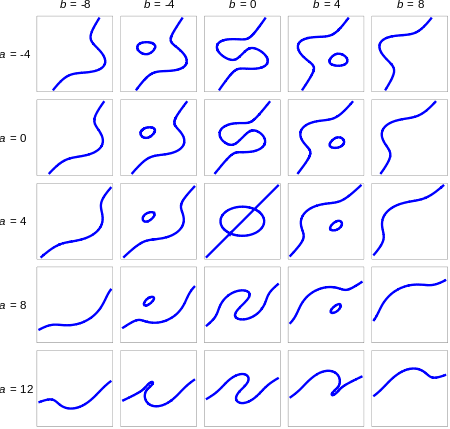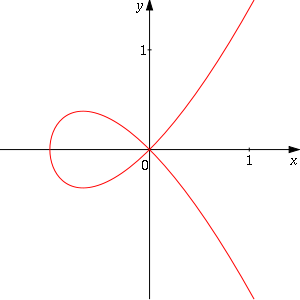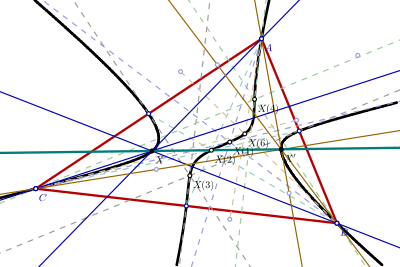Cubic plane curve
In mathematics, a cubic plane curve is a plane algebraic curve C defined by a cubic equation
- F(x, y, z) = 0

applied to homogeneous coordinates x:y:z for the projective plane; or the inhomogeneous version for the affine space determined by setting z = 1 in such an equation. Here F is a non-zero linear combination of the third-degree monomials
- x3, y3, z3, x2y, x2z, y2x, y2z, z2x, z2y, xyz.
These are ten in number; therefore the cubic curves form a projective space of dimension 9, over any given field K. Each point P imposes a single linear condition on F, if we ask that C pass through P. Therefore, we can find some cubic curve through any nine given points, which may be degenerate, and may not be unique, but will be unique and non-degenerate if the points are in general position; compare to two points determining a line and how five points determine a conic. If two cubics pass through a given set of nine points, then in fact a pencil of cubics does, and the points satisfy additional properties; see Cayley–Bacharach theorem.

A cubic curve may have a singular point, in which case it has a parametrization in terms of a projective line. Otherwise a non-singular cubic curve is known to have nine points of inflection, over an algebraically closed field such as the complex numbers. This can be shown by taking the homogeneous version of the Hessian matrix, which defines again a cubic, and intersecting it with C; the intersections are then counted by Bézout's theorem. However, only three of these points may be real, so that the others cannot be seen in the real projective plane by drawing the curve. The nine inflection points of a non-singular cubic have the property that every line passing through two of them contains exactly three inflection points.
The real points of cubic curves were studied by Isaac Newton. The real points of a non-singular projective cubic fall into one or two 'ovals'. One of these ovals crosses every real projective line, and thus is never bounded when the cubic is drawn in the Euclidean plane; it appears as one or three infinite branches, containing the three real inflection points. The other oval, if it exists, does not contain any real inflection point and appears either as an oval or as two infinite branches. Like for conic sections, a line cuts this oval at, at most, two points.
A non-singular plane cubic defines an elliptic curve, over any field K for which it has a point defined. Elliptic curves are now normally studied in some variant of Weierstrass's elliptic functions, defining a quadratic extension of the field of rational functions made by extracting the square root of a cubic. This does depend on having a K-rational point, which serves as the point at infinity in Weierstrass form. There are many cubic curves that have no such point, for example when K is the rational number field.
The singular points of an irreducible plane cubic curve are quite limited: one double point, or one cusp. A reducible plane cubic curve is either a conic and a line or three lines, and accordingly have two double points or a tacnode (if a conic and a line), or up to three double points or a single triple point (concurrent lines) if three lines.
Cubic curves in the plane of a triangle
Suppose that ABC is a triangle with sidelengths a = |BC|, b = |CA|, c = |AB|. Relative to ABC, many named cubics pass through well-known points. Examples shown below use two kinds of homogeneous coordinates: trilinear and barycentric.
To convert from trilinear to barycentric in a cubic equation, substitute as follows:
- x ↦ bcx, y ↦ cay, z ↦ abz;
to convert from barycentric to trilinear, use
- x ↦ ax, y ↦ by, z ↦ cz.
Many equations for cubics have the form
- f(a, b, c, x, y, z) + f(b, c, a, y, z, x) + f(c, a, b, z, x, y) = 0.
In the examples below, such equations are written more succinctly in "cyclic sum notation", like this:
- [cyclic sum f(x, y, z, a, b, c)] = 0.
The cubics listed below can be defined in terms of the isogonal conjugate, denoted by X*, of a point X not on a sideline of ABC. A construction of X* follows. Let LA be the reflection of line XA about the internal angle bisector of angle A, and define LB and LC analogously. Then the three reflected lines concur in X*. In trilinear coordinates, if X = x:y:z, then X* = 1/x:1/y:1/z.
Neuberg cubic
Trilinear equation: [cyclic sum (cos A − 2 cos B cos C)x(y2 − z2)] = 0
Barycentric equation: [cyclic sum (a2(b2 + c2) + (b2 − c2)2 − 2a4)x(c2y2 − b2z2)] = 0
The Neuberg cubic (named after Joseph Jean Baptiste Neuberg) is the locus of a point X such that X* is on the line EX, where E is the Euler infinity point (X(30) in the Encyclopedia of Triangle Centers). Also, this cubic is the locus of X such that the triangle XAXBXC is perspective to ABC, where XAXBXC is the reflection of X in the lines BC, CA, AB, respectively
The Neuberg cubic passes through the following points: incenter, circumcenter, orthocenter, both Fermat points, both isodynamic points, the Euler infinity point, other triangle centers, the excenters, the reflections of A, B, C in the sidelines of ABC, and the vertices of the six equilateral triangles erected on the sides of ABC.
For a graphical representation and extensive list of properties of the Neuberg cubic, see K001 at Berhard Gibert's Cubics in the Triangle Plane.
Thomson cubic

Trilinear equation: [cyclic sum bcx(y2 − z2)] = 0
Barycentric equation: [cyclic sum x(c2y2 − b2z2)] = 0
The Thomson cubic is the locus of a point X such that X* is on the line GX, where G is the centroid.
The Thomson cubic passes through the following points: incenter, centroid, circumcenter, orthocenter, symmedian point, other triangle centers, the vertices A, B, C, the excenters, the midpoints of sides BC, CA, AB, and the midpoints of the altitudes of ABC. For each point P on the cubic but not on a sideline of the cubic, the isogonal conjugate of P is also on the cubic.
For graphs and properties, see K002 at Cubics in the Triangle Plane.
Darboux cubic
Trilinear equation: [cyclic sum (cos A − cos B cos C)x(y2 − z2)] = 0
Barycentric equation: [cyclic sum (2a2(b2 + c2) + (b2 − c2)2 − 3a4)x(c2y2 − b2z2)] = 0
The Darboux cubic is the locus of a point X such that X* is on the line LX, where L is the de Longchamps point. Also, this cubic is the locus of X such that the pedal triangle of X is the cevian of some point (which lies on the Lucas cubic). Also, this cubic is the locus of a point X such that the pedal triangle of X and the anticevian triangle of X are perspective; the perspector lies on the Thomson cubic.
The Darboux cubic passes through the incenter, circumcenter, orthocenter, de Longchamps point, other triangle centers, the vertices A, B, C, the excenters, and the antipodes of A, B, C on the circumcircle. For each point P on the cubic but not on a sideline of the cubic, the isogonal conjugate of P is also on the cubic.
For graphics and properties, see K004 at Cubics in the Triangle Plane.
Napoleon–Feuerbach cubic
Trilinear equation: [cyclic sum cos(B − C)x(y2 − z2)] = 0
Barycentric equation: [cyclic sum (a2(b2 + c2) − (b2 − c2)2)x(c2y2 − b2z2)] = 0
The Napoleon–Feuerbach cubic is the locus of a point X* is on the line NX, where N is the nine-point center, (N = X(5) in the Encyclopedia of Triangle Centers).
The Napoleon–Feuerbach cubic passes through the incenter, circumcenter, orthocenter, 1st and 2nd Napoleon points, other triangle centers, the vertices A, B, C, the excenters, the projections of the centroid on the altitudes, and the centers of the 6 equilateral triangles erected on the sides of ABC.
For a graphics and properties, see K005 at Cubics in the Triangle Plane.
Lucas cubic
Trilinear equation: [cyclic sum (cos A)x(b2y2 − c2z2)] = 0
Barycentric equation: [cyclic sum (b2 + c2 − a2)x(y2 − z2)] = 0
The Lucas cubic is the locus of a point X such that the cevian triangle of X is the pedal triangle of some point; the point lies on the Darboux cubic.
The Lucas cubic passes through the centroid, orthocenter, Gergonne point, Nagel point, de Longchamps point, other triangle centers, the vertices of the anticomplementary triangle, and the foci of the Steiner circumellipse.
For graphics and properties, see K007 at Cubics in the Triangle Plane.
1st Brocard cubic
Trilinear equation: [cyclic sum bc(a4 − b2c2)x(y2 + z2] = 0
Barycentric equation: [cyclic sum (a4 − b2c2)x(c2y2 + b2z2] = 0
Let A′B′C′ be the 1st Brocard triangle. For arbitrary point X, let XA, XB, XC be the intersections of the lines XA′, XB′, XC′ with the sidelines BC, CA, AB, respectively. The 1st Brocard cubic is the locus of X for which the points XA, XB, XC are collinear.
The 1st Brocard cubic passes through the centroid, symmedian point, Steiner point, other triangle centers, and the vertices of the 1st and 3rd Brocard triangles.
For graphics and properties, see K017 at Cubics in the Triangle Plane.
2nd Brocard cubic
Trilinear equation: [cyclic sum bc(b2 − c2)x(y2 + z2] = 0
Barycentric equation: [cyclic sum (b2 − c2)x(c2y2 + b2z2] = 0
The 2nd Brocard cubic is the locus of a point X for which the pole of the line XX* in the circumconic through X and X* lies on the line of the circumcenter and the symmedian point (i.e., the Brocard axis).
The 2nd Brocard cubic passes through the centroid, symmedian point, both Fermat points, both isodynamic points, the Parry point, other triangle centers, and the vertices of the 2nd and 4th Brocard triangles.
For a graphics and properties, see K018 at Cubics in the Triangle Plane.
1st equal areas cubic
Trilinear equation: [cyclic sum a(b2 − c2)x(y2 − z2] = 0
Barycentric equation: [cyclic sum a2(b2 − c2)x(c2y2 − b2z2] = 0
The 1st equal areas cubic is the locus of a point X such that area of the cevian triangle of X equals the area of the cevian triangle of X*. Also, this cubic is the locus of X for which X* is on the line S*X, where S is the Steiner point. (S = X(99) in the Encyclopedia of Triangle Centers).
The 1st equal areas cubic passes through the incenter, Steiner point, other triangle centers, the 1st and 2nd Brocard points, and the excenters.
For a graphics and properties, see K021 at Cubics in the Triangle Plane.
2nd equal areas cubic
Trilinear equation: (bz + cx)(cx + ay)(ay + bz) = (bx + cy)(cy + ax)(az + bx)
Barycentric equation: [cyclic sum a(a2 − bc)x(c3y2 − b3z2)] = 0
For any point X = x:y:z (trilinears), let XY = y:z:x and XZ = z:x:y. The 2nd equal areas cubic is the locus of X such that the area of the cevian triangle of XY equals the area of the cevian triangle of XZ.
The 2nd equal areas cubic passes through the incenter, centroid, symmedian point, and points in Encyclopedia of Triangle Centers indexed as X(31), X(105), X(238), X(292), X(365), X(672), X(1453), X(1931), X(2053), and others.
For a graphics and properties, see K155 at Cubics in the Triangle Plane.
See also
- Cayley–Bacharach theorem, on the intersection of two cubic plane curves
- Twisted cubic, a cubic space curve
- Elliptic curve
- Witch of Agnesi
References
- Bix, Robert (1998), Conics and Cubics: A Concrete Introduction to Algebraic Curves, New York: Springer, ISBN 0-387-98401-1.
- Cerin, Zvonko (1998), "Locus properties of the Neuberg cubic", Journal of Geometry, 63 (1–2): 39–56, doi:10.1007/BF01221237.
- Cerin, Zvonko (1999), "On the cubic of Napoleon", Journal of Geometry, 66 (1–2): 55–71, doi:10.1007/BF01225672.
- Cundy, H. M. & Parry, Cyril F. (1995), "Some cubic curves associated with a triangle", Journal of Geometry, 53 (1–2): 41–66, doi:10.1007/BF01224039.
- Cundy, H. M. & Parry, Cyril F. (1999), "Geometrical properties of some Euler and circular cubics (part 1)", Journal of Geometry, 66 (1–2): 72–103, doi:10.1007/BF01225673.
- Cundy, H. M. & Parry, Cyril F. (2000), "Geometrical properties of some Euler and circular cubics (part 2)", Journal of Geometry, 68 (1–2): 58–75, doi:10.1007/BF01221061.
- Ehrmann, Jean-Pierre & Gibert, Bernard (2001), "A Morley configuration", Forum Geometricorum, 1: 51–58.
- Ehrmann, Jean-Pierre & Gibert, Bernard (2001), "The Simson cubic", Forum Geometricorum, 1: 107–114.
- Gibert, Bernard (2003), "Orthocorrespondence and orthopivotal cubics", Forum Geometricorum, 3: 1–27.
- Kimberling, Clark (1998), "Triangle Centers and Central Triangles", Congressus Numerantium, 129: 1–295. See Chapter 8 for cubics.
- Kimberling, Clark (2001), "Cubics associated with triangles of equal areas", Forum Geometricorum, 1: 161–171.
- Lang, Fred (2002), "Geometry and group structures of some cubics", Forum Geometricorum, 2: 135–146.
- Pinkernell, Guido M. (1996), "Cubic curves in the triangle plane", Journal of Geometry, 55 (1–2): 142–161, doi:10.1007/BF01223040.
- Salmon, George (1879), Higher Plane Curves (3rd ed.), New York: Chelea.